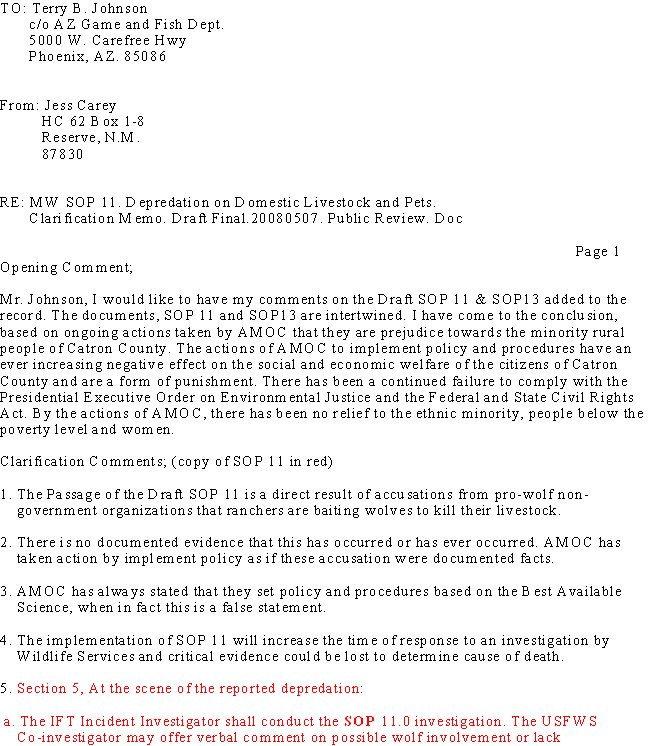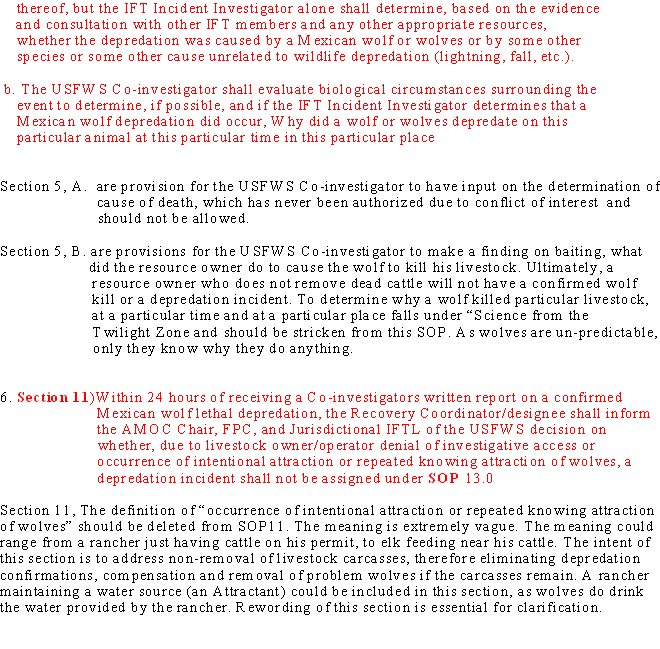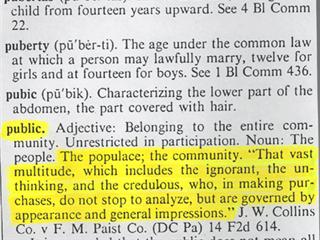Sent: Friday, February 08, 2008 9:25 AM
Subject: MEXICAN WOLF POPULATION SURVEY COMPLETE
--------------------------------------------------------------------------------
From: David.L.Bergman@aphis.usda.gov [mailto:David.L.Bergman@aphis.usda.gov]
Sent: Friday, February 08, 2008 8:00 AM
Subject: MEXICAN WOLF POPULATION SURVEY COMPLETE
MEXICAN WOLF POPULATION SURVEY COMPLETE
Contacts
Elizabeth Slown, 505-248-6909 or 363-9592
--------------------------------------------------------------------------------
There are 52 Mexican wolves that have been counted in the wild at the end of 2007, according to the annual survey conducted by the Interagency Field Team for wolf reintroduction. Surveys are completed in January of each year. Pups born in the summer must survive to December 31 before they are counted into the total Mexican wolf population. There are 29 wolves in Arizona and 23 wolves in New Mexico.
The reintroduction of the Mexican wolf is a cooperative, multi-agency effort between U.S. Fish and Wildlife Service and the Arizona Game and Fish Department, New Mexico Department of Game and Fish, White Mountain Apache Tribe, USDA Forest Service and USDA Animal and Plant Health Inspection Service - Wildlife Services. The agencies have established the Adaptive Management Oversight Committee (AMOC) that jointly manage the wolf reintroduction program in New Mexico and Arizona.
Fixed-wing aircraft were used to locate packs whose members are wearing radio collars. A helicopter was then used to count uncollared wolves that are associated with collared wolves in any particular packs. If a wolf needed capturing, the helicopter crew used net guns or immobilizing drugs delivered via darts. Ten wolves were captured during the census and physically examined and inoculated. Ground crews, including a veterinarian, examined the wolves and administered the following vaccines: rabies; parvovirus, parainfluenza, canine distemper, coronavirus, adenovirus type 2, and Leptospira. These vaccinations help to protect both human and domestic animals, in the recovery area, from serious contagious diseases.
The numbers are down from last year's number of 59 Mexican wolves. Altogether, 22 wolves were removed from the wild in 2007 compared to 18 the previous year; 19 for depredating livestock (this includes their seven dependent pups), two for dispersing outside the Blue Range Wolf Recovery Area and one for nuisance behavior. The alpha pair of the Durango Pack, along with a pup that would have been included in the count, went missing in November. Their disappearance is under investigation.
"Under the existing AMOC Standard Operation Procedures, we have to remove wolves that have three or more depredation incidents within a 12-month period," said Benjamin Tuggle, PhD, Regional Director for the US Fish and Wildlife Service. "The number of wolves we had to remove this past year - based on current protocols - demonstrates the need for an interdiction program that addresses the issue of depredating wolves, provides economic compensation for financial losses, and thereby allows wolves to remain on the landscape."
The fact that there were no initial releases of wolves in 2007 also affected the survey data. Although there were no new releases during the past year, there were some translocations of wolves. The number of new, or re-formed, pairs is five. One of the translocations of a female resulted in a new pair bond for the Hawks Nest pack. Three pairs formed naturally during the year and have been named Elk Mountain pack, Fox Mountain pack and the Dark Canyon Pack.
The number of official breeding pairs in the wild is four. When the number of breeding pairs is less than six, the Service does not issue permits to livestock owners for more aggressive management actions on public lands under certain conditions. Ranchers can always defend their livestock on their private land from attacking wolves.
The Service has initiated a public process to revise its rule that governs the Mexican wolf reintroduction project and will be analyzing alternatives to refine and improve reintroduction.
"With the revision of the project's governing rule that is underway, we fully expect that there will be fruitful changes made that improve the wolf reintroduction program, and will ultimately lead to greater numbers of wolves in the wild," said Tuggle.
In addition, the AMOC has been reviewing and clarifying its operating procedures to strengthen wolf reintroduction efforts. The standard procedures describe how management actions are implemented. Standard operating procedures are collaboratively developed and can be modified by the AMOC. The governing rule regulating wolf reintroduction is subject to federal rulemaking procedures.
______________________________________________________________________
The mission of the U.S. Fish and Wildlife Service is working with others to conserve, protect and enhance fish, wildlife, plants and their habitats for the continuing benefit of the American people. We are both a leader and trusted partner in fish and wildlife conservation, known for our scientific excellence, stewardship of lands and natural resources, dedicated professionals and commitment to public service. For more information on our work and the people who make it happen, visit www.fws.gov.
KOLD News 13
Fish and Wildlife finishes counting Mexican gray wolves
Associated Press - February 7, 2008 7:24 PM ET
ALBUQUERQUE, N.M. (AP) - There are 52 Mexican gray wolves in the wild on the New Mexico-Arizona border -- seven fewer than last year.
That's according to the U.S. Fish and Wildlife Service's just completed annual count of the animals.
The survey counted 29 wolves in Arizona and 23 in New Mexico.
The counts are done each January. In 2007, the survey found 59 wolves, about half in each state.
Twenty-two wolves were removed from the wild in 2007 -- 19 of them either for killing livestock or because they were young pups associated with a parent wolf that killed livestock.
Fish and Wildlife says two were removed for moving outside the wolves' designated range, and the other was removed for nuisance behavior.
In addition, three wolves disappeared in November.
Posts and Comments from Readers
Please include yourself in the discussion. Post a comment.
Friday, February 8, 2008
MEXICAN WOLF POPULATION SURVEY COMPLETE
Subscribe to:
Post Comments (Atom)



















.jpg)


















No comments:
Post a Comment